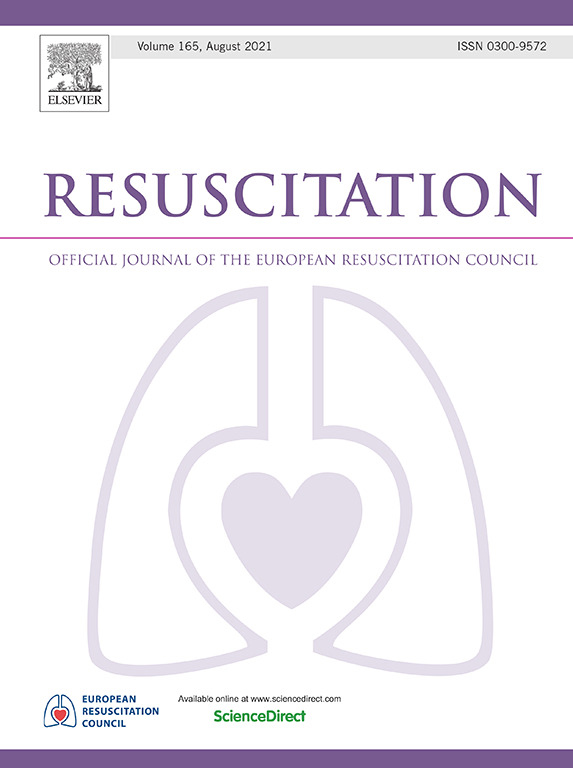开始派遣辅助旁观者心肺复苏(DA-CPR)所需时间与院外心脏骤停(OHCA)结果之间的关系
IF 4.6
1区 医学
Q1 CRITICAL CARE MEDICINE
引用次数: 0
摘要
背景:我们旨在调查开始调度员辅助心肺复苏(DA-CPR)所需时间与OHCA生存结局之间的关系。方法:回顾性分析2012年至2021年新加坡泛亚复苏结果研究数据。我们纳入了所有接受DA-CPR的成人、目击者、非创伤性OHCA患者。兴趣暴露为从紧急呼叫到开始DA-CPR的时间间隔。根据以往的研究将患者分为三组。结果定义为存活至30天,神经系统预后良好。进行多变量logistic回归分析。限制三次样条曲线用于探索非线性关系。结果:3861例OHCA患者纳入本分析。患者按短(0 ~ 179秒)、中(180 ~ 239秒)、长(≥240秒)开始DA-CPR分组。存活至30天神经系统预后良好的校正比值比[95% CI]为:中期0.82[0.52-1.28],长期0.63[0.40-0.98]。限制性三次样条曲线显示存活至30天的优势比单调下降,神经系统预后良好。结论:本研究发现,在接受DA-CPR的非创伤性OHCA患者中,较短的DA-CPR开始时间与较好的30天生存率和良好的神经预后相关。本文章由计算机程序翻译,如有差异,请以英文原文为准。
Association between time taken to start dispatch assisted-bystander cardiopulmonary resuscitation (DA-CPR) and outcomes for out-of-hospital cardiac arrest (OHCA)
Background
We aimed to investigate the association between the time taken to start dispatcher-assisted cardiopulmonary resuscitation (DA-CPR) and survival outcomes for OHCA.
Methods
This was a retrospective analysis using the Singapore Pan-Asian Resuscitation Outcomes Study data between 2012 and 2021. We included all adult, witnessed, non-traumatic OHCA patients who received DA-CPR. The exposure of interest was time interval from emergency call to start of DA-CPR. Patients were divided into three groups based on previous studies. The outcome was defined as survival to 30-days with favorable neurological outcomes. Multivariable logistic regression analysis was performed. Restricted cubic spline curves were used to explore non-linear relationships.
Results
3,861 OHCA patients were included in this analysis. Patients were grouped as follows: short (0–179 s), medium (180–239 s), and long (≥240 s) to start DA-CPR. Adjusted odds ratios [95% CI] for survival to 30-days with favorable neurological outcomes were: medium 0.82 [0.52–1.28], long 0.63 [0.40–0.98]. The restricted cubic spline curve showed a monotonic decrease in the odds ratio for survival to 30-days with favorable neurological outcomes.
Conclusions
This study found that among non-traumatic, witnessed OHCA patients who received DA-CPR, a shorter time to start DA-CPR was associated with better 30-day survival with favorable neurological outcomes.
求助全文
通过发布文献求助,成功后即可免费获取论文全文。
去求助
来源期刊

Resuscitation
医学-急救医学
CiteScore
12.00
自引率
18.50%
发文量
556
审稿时长
21 days
期刊介绍:
Resuscitation is a monthly international and interdisciplinary medical journal. The papers published deal with the aetiology, pathophysiology and prevention of cardiac arrest, resuscitation training, clinical resuscitation, and experimental resuscitation research, although papers relating to animal studies will be published only if they are of exceptional interest and related directly to clinical cardiopulmonary resuscitation. Papers relating to trauma are published occasionally but the majority of these concern traumatic cardiac arrest.
 求助内容:
求助内容: 应助结果提醒方式:
应助结果提醒方式:


